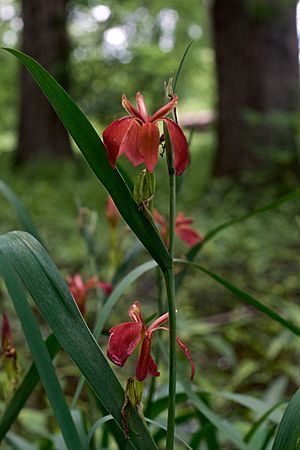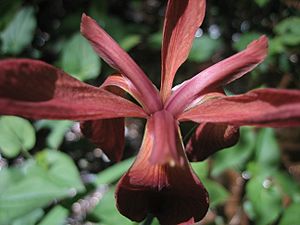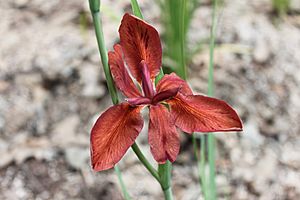Copper iris facts for kids
Quick facts for kids Copper iris |
|
|---|---|
 |
|
| Conservation status | |
| Scientific classification | |
| Genus: |
Iris
|
| Species: |
fulva
|
| Synonyms | |
|
|
The Iris fulva, also known as the copper iris, is a beautiful type of iris flower. It belongs to a group called Limniris and is part of the Hexagonae series. This plant grows from thick underground stems called rhizomes. It is a perennial plant, which means it lives for more than two years. You can find it naturally in the southern and central parts of the United States. The copper iris is famous for its unique copper-red to deep red flowers and bright green leaves.
Contents
What Does the Copper Iris Look Like?
Roots and Stems
The copper iris has thin, greenish-brown rhizomes that grow underground. Sometimes, these rhizomes can be red. They have ring-like marks from old leaves. These rhizomes are about 1.5–2 cm (about 1 inch) wide. They don't grow very deep into the soil. These roots can spread out and form large groups of plants, about 1–2 feet wide.
Leaves
New leaves start to grow in the autumn. They stay green through winter and into spring. This means the plant usually only loses its leaves around August. The leaves are bright green and shaped like long, narrow blades. They have light ridges that run parallel to the stem. The leaves grow from the bottom of the plant and then arch away from the stem. They can be very long, from 60 to 100 cm (about 2 to 3 feet) long. They are about 1–2 cm (½ to 1 inch) wide. Some leaves also grow along the flower stem.
Flower Stems
The flower stem usually stands straight up. It can have one or two branches. These stems can grow quite tall, reaching between 45 and 80 cm (about 1.5 to 2.5 feet) high. The stem is a medium green color. It has 1 to 3 leaves growing along it. These leaves look like the main leaves but are smaller.
Flowers and Blooming Time
The copper iris usually blooms in spring and early summer, from April to June. Each stem can have 4 to 6 flowers, sometimes even more. The flowers bloom for about 3 weeks in total. However, each individual flower only lasts for about 1 to 4 days. In places like Australia and New Zealand, they bloom from September to November.
The flowers have a light scent. They come in many shades of red. You might see copper-red, brick-red, rust-red, or deep red colors. Sometimes, you can even find yellow flowers. Unlike many other irises, the lower petals (called falls) and the upper petals (called standards) are the same color.
The copper iris is special because all six of its petals droop downwards. The flowers are wide open. The three lower petals (falls) are about 2.25–2.5 in (5.7–6.4 cm) long and 1–1.25 in (2.5–3.2 cm) wide. The three upper petals (standards) are about 4.5 cm (1.8 in) long and 5–7 cm (2–2.8 in) across. The center of each flower is yellowish and shaped like a tube.
Inside the flower, the female parts (styles) are short, about 2 cm (0.8 in) long. The stigma, which collects pollen, has two small pointed tips. The parts that hold the pollen (filaments) are yellow. The pollen itself is cream-colored.
Seed Pods and Seeds
The copper iris produces green seed pods, also called capsules. These pods have six sides and are oval-shaped. They measure between 4.5–8 cm (1.8–3.1 in) long and about 2.5 cm (1 in) wide. The seeds are stored in two rows inside these pods. The seeds are flat and have irregular shapes, about 10–15 mm (0.4–0.6 in) wide. Like other Louisiana irises, the seeds have a cork-like coating. This coating helps them float on water, allowing them to spread to new places in swamps.
Genetics of the Copper Iris
Most irises are diploid, meaning they have two sets of chromosomes. This helps scientists identify different types of irises. The copper iris has 42 chromosomes (written as 2n=42). This number is important for understanding how it might create new types of irises when it mixes with other species.
Where Does the Copper Iris Come From?
Naming the Plant
The common name for Iris fulva is 'Copper Iris'. The Latin word 'Fulva' means 'tawny-orange'. This name perfectly describes the flower's color.
The plant was first found and collected in 1811. It was growing along the banks of the Mississippi River near New Orleans. John Bellenden Ker Gawler officially described and published its name in 1812.
An artist named John James Audubon even featured the copper iris in his famous book, "Birds of America". In one picture, two birds are shown sitting on a copper iris plant. This connection helped a group of irises in Louisiana become known as the "Louisiana Irises".
The Iris fulva is an accepted plant name by the RHS. It has even received the Award of Garden Merit, which means it's a great plant for gardens.
Where Does the Copper Iris Grow Naturally?
Its Home Range
The copper iris is native to North America. You can find it in many southern and central U.S. states. These include Arkansas, Illinois, Kentucky, Louisiana, Mississippi, Missouri, Ohio, Georgia, Florida (though rarely), and Tennessee.
Where It Likes to Live
The copper iris loves wet places. It grows in freshwater marshes, along stream banks, in ditches by fields or roads, in drainage canals, swamps, and wet pastures. It can usually be found in water up to 6 in (15 cm) deep.
Is the Copper Iris Protected?
The copper iris is listed as 'endangered' in Kentucky and Tennessee. It is 'threatened' in Illinois. This means there aren't as many of these plants as there used to be. The main reason for this is that their natural homes are being lost. Swamps are being drained, and harmful farm chemicals can run into their water sources.
How to Grow the Copper Iris
Growing Conditions
Louisiana irises, including the copper iris, generally need similar care. They need lots of sunlight, at least 6 hours a day in summer. They prefer moist, slightly acidic soils (around pH 6.5). The soil should also have plenty of organic material and be rich in nutrients.
For the best flowers, the plant needs lots of moisture from late autumn through spring (October to May). This is when new leaves are growing. You can give them a light feeding between autumn and spring if needed.
The copper iris is quite tough. It can grow in USDA Hardiness Zones 3 to 10. This means it can handle cold winters. It can tolerate frost, but it won't flower well in places with cool summers.
You can grow them in the southern UK, New Zealand, and Australia if the soil is damp or wet.
Planting Tips
You can plant copper irises by the edges of ponds or pools. You can even plant them directly in the water, up to 6 inches deep. If planting in water, you need to pin the rhizomes to the ground so they don't float away. Also, cover the rhizomes with gravel to stop fish from disturbing the roots. They can also be planted in streams, but not in fast-flowing rivers.
Copper irises can also grow in pots. If you grow them in containers, you should re-pot and divide them every year. If you use fertilizer, sprinkle it around the plant in late January or February, before the flowers appear. New plants should have a layer of mulch to protect them from too much sun. Plants grown in water don't need mulch and often grow faster.
How to Make More Copper Irises
The easiest way to get more copper irises is by dividing the rhizomes. This is best done in late summer when the plants are resting. Prepare the soil by adding plenty of organic material and digging about 6 inches deep. This helps new roots grow. You should divide the plants every 3–4 years to keep them flowering well.
Growing irises from seed is possible but very slow. It can take many months for the seeds to sprout (3–12 months). Only about half of the seeds will grow. Then, it can take 3–5 years before these new plants produce flowers.
You should collect seeds from the plant after it flowers, but make sure the seed pods are mature. Store the seeds in paper bags. If you store them in glass containers, they might get moldy.
Who Helps Pollinate the Flowers?
The copper iris is mainly pollinated by ruby-throated hummingbirds. These tiny birds visit the flowers looking for nectar. The flowers also attract butterflies.
New Types of Copper Irises
The Iris fulva can easily mix with other Louisiana irises to create new kinds of plants. The first hybrid was called 'Iris fulvala'. It was a mix between Iris fulva and Iris brevicaulis. This cross produced beautiful flowers with rich, velvety petals. These new hybrid plants were often better for gardens and flowered more easily than their parent plants. Other mixes include 'Iris × vinicolor' and 'Iris × cacique'.
Many garden nurseries have created new varieties of Iris fulva. Some of these include 'Apricot Queen', 'August Flame', 'Autumn Fire', 'Chocolate', 'Golden Arrowhead', and 'Louisiana Sunset'.
Is the Copper Iris Poisonous?
Some parts of the iris plant are poisonous. Both the leaves and the rhizomes are toxic. Because of this, most plant-eating animals usually leave irises alone. However, Muskrats sometimes eat their rhizomes and lower stems. White-tailed deer might nibble on the edges of the leaves.
Images for kids







